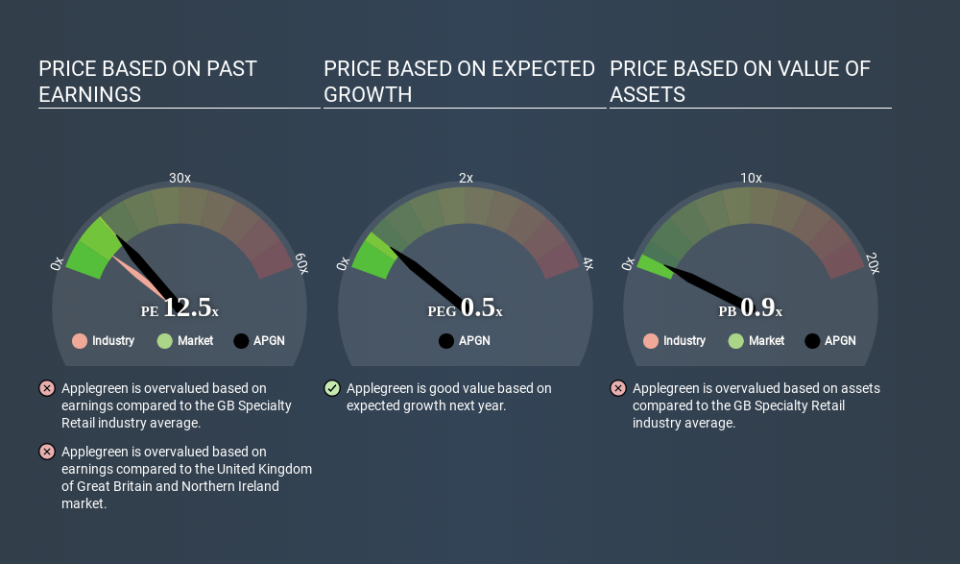A Sliding Share Price Has Us Looking At Applegreen plc's (LON:APGN) P/E Ratio

Unfortunately for some shareholders, the Applegreen (LON:APGN) share price has dived 56% in the last thirty days. Indeed the recent decline has arguably caused some bitterness for shareholders who have held through the 59% drop over twelve months.
All else being equal, a share price drop should make a stock more attractive to potential investors. In the long term, share prices tend to follow earnings per share, but in the short term prices bounce around in response to short term factors (which are not always obvious). So, on certain occasions, long term focussed investors try to take advantage of pessimistic expectations to buy shares at a better price. Perhaps the simplest way to get a read on investors' expectations of a business is to look at its Price to Earnings Ratio (PE Ratio). A high P/E ratio means that investors have a high expectation about future growth, while a low P/E ratio means they have low expectations about future growth.
See our latest analysis for Applegreen
How Does Applegreen's P/E Ratio Compare To Its Peers?
We can tell from its P/E ratio of 12.54 that there is some investor optimism about Applegreen. As you can see below, Applegreen has a higher P/E than the average company (7.8) in the specialty retail industry.
Applegreen's P/E tells us that market participants think the company will perform better than its industry peers, going forward. Shareholders are clearly optimistic, but the future is always uncertain. So investors should delve deeper. I like to check if company insiders have been buying or selling.
How Growth Rates Impact P/E Ratios
If earnings fall then in the future the 'E' will be lower. That means even if the current P/E is low, it will increase over time if the share price stays flat. Then, a higher P/E might scare off shareholders, pushing the share price down.
Applegreen increased earnings per share by a whopping 31% last year. But earnings per share are down 2.7% per year over the last five years.
Don't Forget: The P/E Does Not Account For Debt or Bank Deposits
It's important to note that the P/E ratio considers the market capitalization, not the enterprise value. That means it doesn't take debt or cash into account. Theoretically, a business can improve its earnings (and produce a lower P/E in the future) by investing in growth. That means taking on debt (or spending its cash).
Spending on growth might be good or bad a few years later, but the point is that the P/E ratio does not account for the option (or lack thereof).
Is Debt Impacting Applegreen's P/E?
Applegreen has net debt worth a very significant 220% of its market capitalization. If you want to compare its P/E ratio to other companies, you must keep in mind that these debt levels would usually warrant a relatively low P/E.
The Verdict On Applegreen's P/E Ratio
Applegreen trades on a P/E ratio of 12.5, which is fairly close to the GB market average of 12.5. It does have enough debt to add risk, although earnings growth was strong in the last year. The P/E suggests the market isn't confident that growth will be sustained, though. What can be absolutely certain is that the market has become significantly less optimistic about Applegreen over the last month, with the P/E ratio falling from 28.4 back then to 12.5 today. For those who prefer to invest with the flow of momentum, that might be a bad sign, but for a contrarian, it may signal opportunity.
Investors should be looking to buy stocks that the market is wrong about. If it is underestimating a company, investors can make money by buying and holding the shares until the market corrects itself. So this free visualization of the analyst consensus on future earnings could help you make the right decision about whether to buy, sell, or hold.
Of course you might be able to find a better stock than Applegreen. So you may wish to see this free collection of other companies that have grown earnings strongly.
If you spot an error that warrants correction, please contact the editor at editorial-team@simplywallst.com. This article by Simply Wall St is general in nature. It does not constitute a recommendation to buy or sell any stock, and does not take account of your objectives, or your financial situation. Simply Wall St has no position in the stocks mentioned.
We aim to bring you long-term focused research analysis driven by fundamental data. Note that our analysis may not factor in the latest price-sensitive company announcements or qualitative material. Thank you for reading.

 Yahoo News
Yahoo News 

